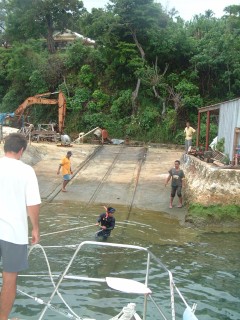
Railway workers positioning lines to center Ocelot over the (sunken) car.
They were so clueless and took so long that we never made it out this day.
|
Top Level Ocelot Pages |
Tonga Haul Out
 Railway workers positioning lines to center Ocelot over the (sunken) car. They were so clueless and took so long that we never made it out this day. |
This account of our Tongan 2004 haul-out comes from Sue and Amanda's diary. For Jon's newsletter on the accident and the haul-out, see his Newsletter. Given that our last haul out was almost two years earlier, and that we had major engine work to do after our mishap in the Ha'apai, we arranged to haul Ocelot on the marine railway in Neiafu, capital of the Vava'u Group of Tonga. We had originally planned to haul on August 31, but it took the railway men several hours to get us situated over the rails and by then the tide as too low. The wind howled from the east for the next week, so we decided to skip it and haul on Monday, September 6.
We hauled out around 13:00, with positioning going easier than a week earlier. With only one engine, it was tricky to position Ocelot over the rails, but we had both Amanda in our dinghy, and Chris Yates from Lady Starlight to play tugboat for us. Everything was set up in about half an hour, the winch started up, and in a few minutes Ocelot was high and dry.
There was just enough time for a few wisecracks from Amanda in the dinghy about being left behind, when we all felt a bit of a clunk. Suddenly Jon, Sue and Chris in the cockpit were grabbing hold of lifelines and the helm seat as the car Ocelot was sitting on, with Ocelot still attached, rocketed back down the railway and into the water! It sounded (and felt) like a runaway freight train. Apparently a rusty pin had fallen out of the winch. The yard men gave it a few whacks with a handy rock and told us it wouldn't happen again.
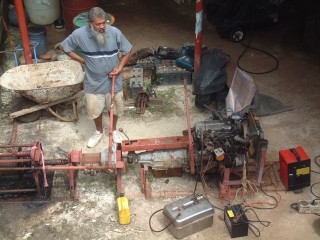 Tongan Dave and his somewhat temperamental railway winch. It's actually an old car engine mated to a pair of junked gearboxes, & held together with bailing wire... |
Thankfully there was no damage from the slide, aside from a few temporarily stopped hearts. All the ropes had held, and we were basically still where we should be on the railway. It only needed a few tugboat moments to get Ocelot back in position. Then we were hauled up again, and chocks were carefully put in place before the clutch was released.
The main projects we had to work on were re-mounting the starboard engine and sail-drive, repairing the dinghy and outboard engine, raising the waterline on Ocelot, polishing the topsides, and painting (primer and antifouling) the main hull, the aluminum saildrives and dinghy bottom.
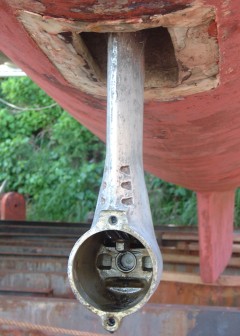 The stbd saildrive, mounted but without prop or flaps. We removed the gearing to check the bearings & replace the seals. |
All told, we were out of the water 8 days, with 2 days of rain, and a supposed day of rest on Sunday. The haul-out cost US$125 for in and out, plus $20 per day for the first 2 days, then $30 each day after that. One gallon of epoxy primer for the waterline cost $140, 28 litres of anti-fouling paint cost $700 (on sale, 1/3 off), and the aluminum primer and aluminum antifouling cost $100, all bought locally in Vava'u at Pacific Timber and Hardware. The Tongan fishermen's wages were $5 per day, with the exception of Dave, the outboard expert, to whom we paid $75 for one job. The new engine mounts and seals from New Zealand came to $1,000. All up, about $2,500, (including incidentals like sandpaper and paint brushes), plus the added cost of meals out.
Starboard engine and sail-drives: The saildrive is like an outboard engine foot that sticks down through the hull, replacing the gearbox and prop-shaft. While Sue and the kids attacked the old anti-fouling paint, Jon got to work on the starboard engine, replacing its shredded engine mounts and disassembling the saildrive so he could replace its seals. He spent the whole second day on the saildrive, getting the seals (which we'd ordered from New Zealand) replaced. At the end of the day he was able to reattach the saildrive to the rest of the engine with the assistance of a few friends who had stopped by. It was great that all this had gone so easily, because he couldn't work on the engine on Wednesday or Thursday due to pouring rain.
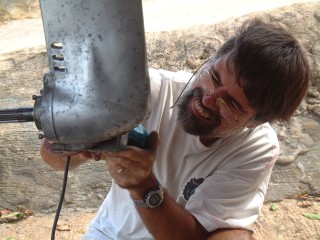 Jon cleans the saildrive to remove all of the old copper paint before painting with an aluminum primer. |
On the rainy Thursday, we hired local fishermen (Dave & Simon) to scrape the old paint off the underwater parts of both saildrives. Dave repaired the starboard alternator that got flooded in The Accident. Under the shed Jon worked on the engine mounts - he was set back by discovering that one mount had bolt holes in the wrong places, so he had to grind and file new ones. On Friday the engine was ready for re-mounting, and Sue raised & lowered the engine on command via a rope and pulley to the starboard sheet winch. It was easier than it sounds thanks to Jon's engineering!
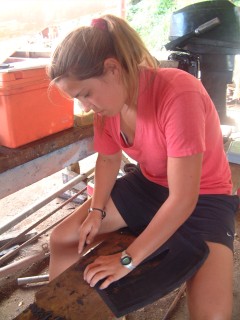 Amanda cuts new rubber flaps (from truck tire flaps) to seal the saildrives. |
On Saturday Amanda cut, fit and applied the rubber external "flaps" around the saildrives, which took several hours. Jon did the last sanding on the saildrives and helped Sue and Amanda with the flaps.
Repair dinghy and outboard: When we pulled Tomcat (our inflatable dinghy) up and flipped it over, we discovered a crack in the aluminum hull. We hired local fishermen to scrape the old (copper based) bottom paint off of the aluminum dinghy bottom. The sound was horrific -- like fingernails on the blackboard. Jon scraped more the next few days, especially on the 2 rainy days when he had to work under the shed. We wanted to weld the aluminum hull, which would give us a permanent fix, but there were no facilities available for welding aluminum (which require an inert gas atmosphere). So Jon put a fiberglass patch on Tomcat's crack, which held until we could do a proper weld-repair in Fiji. Jon also put 5200 (a very strong flexible polysulfide sealant) around the seam where the hull joins the inflatable pontoons. Chris, between working on his Whale Watching Database (senior project for school), scraped the transom on the dinghy, readying it for primer and paint. On Friday Jon did the last sanding on the bottom of Tomcat, so we could prime and paint the bottom.
 Amanda having fun cleaning the hull with the borrowed power sprayer. |
The outboard engine work was given to Dave, the Tongan owner of the fishing boat "Miss Marie". He's apparently the best outboard engine mechanic in Vava'u. With the help of Jon and Chris, the three fishermen took the outboard engine off Tomcat and set to work gently tapping at the tilt-bar which had been rusted solid for over a year. They sanded and greased it till it rotated smoothly. They also made another aluminum latch to keep the engine cover in place and replaced the leaky water elbow that had caused the problem in the first place. Bravo! This job cost an unexpected 150 pa'anga ($75) but was worth it! We depend on our dinghy so much because we almost never go to a marina (besides costing money, there usually aren't any around). So we anchor out and take Tomcat to get to wherever we want to go. This makes us extremely reliant on our dinghy - it's very much like our car.
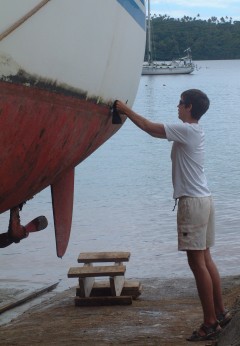 Chris attacks the dirty waterline with scrubbies and lots of elbow grease. |
Raising the waterline: Cruising boats eventually get weighted down with all the paraphernalia of cruising. To keep the sea water from sitting on the somewhat porous gelcoat, they need to raise the waterline. We started work on the hull as soon as we were hauled out, using the power sprayer (borrowed from Lady Starlight) and plastic scrubbies. Surprisingly, the power sprayer didn't work very well on the water line (hence the plastic scrubbies and elbow grease), but it peeled the grunge off the hull in record time. Chris and Amanda almost argued about who got to use the power sprayer. It took about 4 hours to get the bottom clean. The second morning (Tuesday) we finished power washing, and then Chris completely sanded both hulls from the waterline down. Not fun.
Amanda worked on marking out the new waterline, 3" (8cm) above the old one. This was complicated by the fact that the 2 hulls were not symmetrical, and finding good reference lines was difficult, so laying out the new waterlines went on for several days, much to Amanda's frustration.
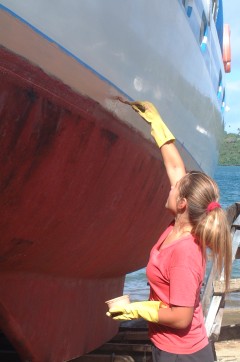 Amanda applies epoxy primer to her newly raised and taped waterline |
Amanda and Sue finished marking the waterline on Friday, doing the best they could. Friends on Sloepmouche told us it would have been easier if we'd marked the waterline while in the water on a very calm day. Maybe so, but the differences in fuel and water on board could make a difference to how the line looked as well. Once the line was penciled on, Chris taped the waterline with blue masking tape, then wiped it down with acetone ready for the epoxy primer.
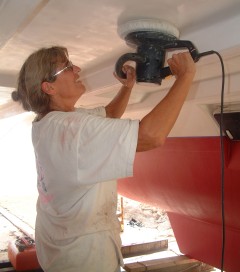 Sue takes on the polisher, under the hulls. First coat of paint is already on. |
Amanda mixed the epoxy primer for the waterline and then left to go sail in the Friday afternoon races. Sue primed the waterline on Ocelot late in the day.
On Saturday Jon ground back a spot on the rudder that was weeping water. Unfortunately, he also ground off part of his thumb, so Sue handled the reconstruction. It was her first full epoxy project. She spent hours drying it with a heat gun borrowed from Sunsail. When all the water was gone she mixed epoxy with micro-balloons to form a syringe-able paste, and squirted it in. Then she laid down a 3-layer fiberglass patch, covering it all with epoxy mud for fairing.
Topsides: With the help of a fisherman named Simon we waxed and polished the hulls, using a buffer we borrowed from Sunsail. It's the first time Ocelot has been polished in three years - and she looks gorgeous! On Tuesday, Simon and Chris cleaned and polished the inside aft hulls and the sugar-scoops, avoiding the nicks in the gelcoat that needed filling. We couldn't do anything on the topsides in the rain, but finished up on Saturday. We had hoped to hire Simon to finish polishing the port (outside) hull - but his boss said he couldn't work that day because they had to prep to go out fishing on Monday (no work Sunday). Sue was annoyed and tried to set up the sawhorse to polish the hull herself, but realized how dangerous that could be. Jon suggested Chris do it - and he did a great job. Those extra 5 inches in height really help!
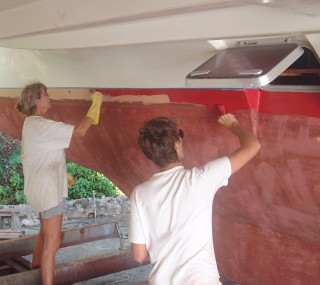 Sue and Chris putting on the first layer of antifouling. The old antifouling was actually in pretty good shape. |
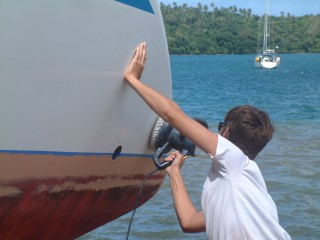 Chris did the bulk of polishing the outer hulls. His 6'4" (1.9m) height really helped here. |
Painting: It was Saturday evening when all the painting preps were done, so we had to give up on the idea of putting back in the water on Monday. Sunday is an enforced day of rest for all of Tonga, so we were not charged for this day on the hard, but we were anxious to finish ASAP. Our own beliefs do not prohibit work on Sunday, so we chose to do some surreptitious work... we didn't want to flaunt their law. Jon and Sue got up by 7:30 am - which meant the sun was up and the mosquitoes had retired for the day. Our goal was to prime the saildrives, dinghy bottom, and the base of the outboard, all with a special aluminum primer. While we waited the needed 15 minutes after mixing the 2 parts we watched Beluga Divers fill their boat with tourists and head out. No work on Sunday? Hmmm... They seem to get away with it quite openly. Anyway, Chris made pancakes, and Chris and Amanda ate while Jon and Sue painted the dinghy and saildrives quietly under the boat and under the shed. We finished three batches of primer, with all crucial surfaces well-covered, then had breakfast.
By 10:10 the church music had started - and to the glory of voices raised in praise, Sue disguised the vibrant song of our palm sander to finalize the fiberglass repair she'd done on the base of the starboard rudder. It must have worked, as no inquisitive Tongans came down the driveway to see what the racket was about. She applied primer, ready for the patch to receive its multiple layers of antifouling.
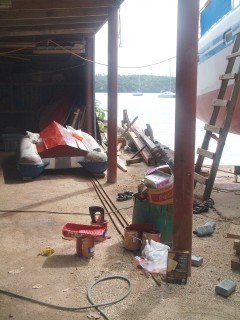 The work-shed, which gave shelter from the hot sun as well as the rain. |
Out of sight under the shed, Amanda used our old 110 volt drill with a long stirring rod to mix the red antifouling. Then she painted the waterline with a small brush, with Chris following with roller. Together they hit all the "hotspots" like the bows and sterns -- parts of the hull that get the most wear or UV, and need extra paint. Then we settled in for our day of rest -- reading, visiting friends who came by, and doing school work.
On Monday we applied the remaining 3 layers of antifouling, doubling the layers on the waterline, rudders and other hotspots. In all we used 28 litres (7 gallons) of a New Zealand ablative red copper-based paint. Dressed in ancient clothes, wearing caps and face masks, it was a hot and fume-filled day, but so satisfying to see the hull come bright and uniform red.
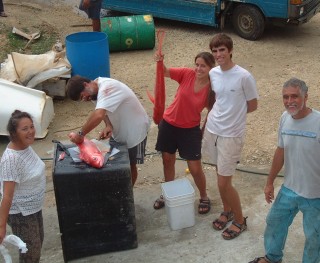 Cleaning some delicious deep sea Red-fish, with cruising friends Mady & Alain from Tico-Tico |
We were put back in the water, clean and gorgeous, early Tuesday morning, September 13.
Surviving a haul-out: Although it's not much fun to sleep at a slant on a marine railway, and have to climb down a 10-foot ladder to get to the toilet and showers, there are things we do to keep sane. For one, we went out to eat almost every night on the hard. We also met up with cruising friends (Lady Starlight, Kiss, Sloepmouche, Gambit, Island Spirit, Willy Flippit, Tico-Tico, etc.) for happy hour and dinners at the Mermaid and Ana's Cafe. On Friday, Chris and Amanda took off at 4pm to join in the yacht races. On the rainy days Amanda and Sue made fun lunches, or ran errands into town to break the monotony. In the evenings we watched DVDs or had supper on other boats. We also enjoyed chatting to the local fishermen and buying some great deep sea fish which friends barbecued for us. We had picnic lunches in the shade of Ocelot, sitting on the rails, where we could admire our handiwork. And there was endless fresh water for cool showers. All in all, not so bad.
Top Level: Home | Destinations | Cruising Info | Underwater | Boat Guests | Ocelot | Sue | Jon | Amanda | Chris | Site Map | Make a Comment
|
If our information is useful, you can help by making a donation |
Copyright © 2000‑ Contact: Jon and Sue Hacking -- HackingFamily.com, svOcelot.com. All rights reserved.